国际投资学第二章国际投资理论课本精炼知识点含课后习题答案
- 格式:doc
- 大小:22.00 KB
- 文档页数:8
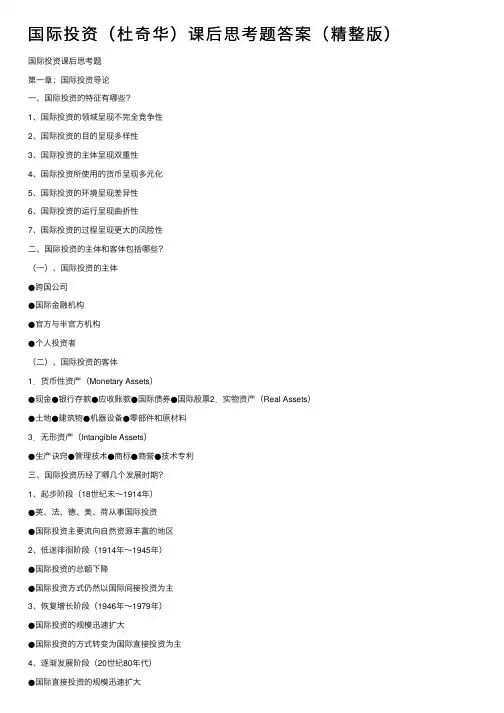
国际投资(杜奇华)课后思考题答案(精整版)国际投资课后思考题第⼀章:国际投资导论⼀、国际投资的特征有哪些?1、国际投资的领域呈现不完全竞争性2、国际投资的⽬的呈现多样性3、国际投资的主体呈现双重性4、国际投资所使⽤的货币呈现多元化5、国际投资的环境呈现差异性6、国际投资的运⾏呈现曲折性7、国际投资的过程呈现更⼤的风险性⼆、国际投资的主体和客体包括哪些?(⼀)、国际投资的主体●跨国公司●国际⾦融机构●官⽅与半官⽅机构●个⼈投资者(⼆)、国际投资的客体1.货币性资产(Monetary Assets)●现⾦●银⾏存款●应收账款●国际债券●国际股票2.实物资产(Real Assets)●⼟地●建筑物●机器设备●零部件和原材料3.⽆形资产(Intangible Assets)●⽣产诀窍●管理技术●商标●商誉●技术专利三、国际投资历经了哪⼏个发展时期?1、起步阶段(18世纪末~1914年)●英、法、德、美、荷从事国际投资●国际投资主要流向⾃然资源丰富的地区2、低迷徘徊阶段(1914年~1945年)●国际投资的总额下降●国际投资⽅式仍然以国际间接投资为主3、恢复增长阶段(1946年~1979年)●国际投资的规模迅速扩⼤●国际投资的⽅式转变为国际直接投资为主4、逐渐发展阶段(20世纪80年代)●国际直接投资的规模迅速扩⼤●国际投资的流动转向以发达国家为主。
5、⾼速增长阶段(20世纪90年代)●国际直接投资总额⼤幅上升●国际直接投资产业分布的转化●国际投资主体向多元化发展●新兴的发展中国家成为国际投资的热点五、国际投资学的研究⽅法有哪些?●总量分析与个量分析相结合●静态分析与动态分析相结合●定性分析与定量分析相结合●历史分析与逻辑分析相结合●抽象分析与实证分析相结合●理论总结与实践操作相结合六、国际投资的最新发展趋势有哪些?●全球外国直接投资增速下降●⼤型跨国公司主宰全球经济●外国直接投资流量继续集中在欧、⽇、美●政府加速开放外国直接投资政策●签订了更多的双边协定和投资协议●中国将成为全球最具活⼒的外商投资地区第⼆章国际直接投资理论⼆、垄断优势理论与内部化理论的主要区别是什么?⾸先,垄断优势理论是以市场不完全作为跨国经营的前提内部化理论的⽬的是消除市场的不完全性;其次,垄断优势理论中由于市场不完全导致垄断排斥竞争内部化理论中由于市场不完全导致市场失灵再次,垄断优势理论注重技术垄断优势,是跨国经营的重要意义内部化理论中交易成本最⼩,注重保证跨国经营的优势最后,垄断优势理论适⽤于发达国家内部化理论既适⽤于发达国家,也适⽤于发展中国家,即可适⽤于国内,也可适⽤于国外。
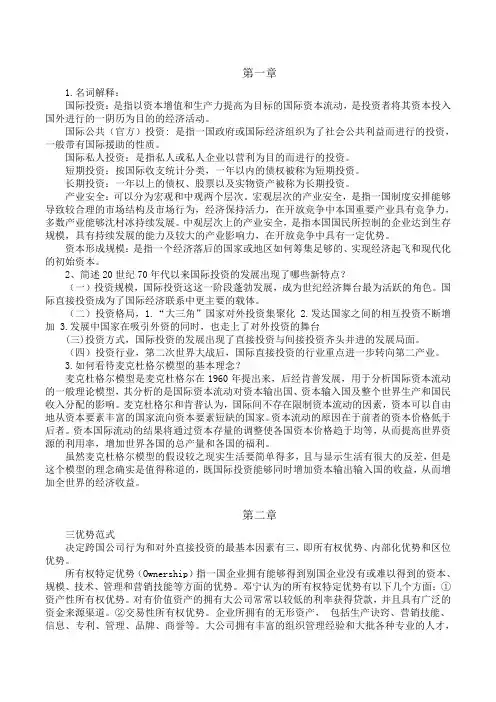
第一章1.名词解释:国际投资:是指以资本增值和生产力提高为目标的国际资本流动,是投资者将其资本投入国外进行的一阴历为目的的经济活动。
国际公共(官方)投资: 是指一国政府或国际经济组织为了社会公共利益而进行的投资,一般带有国际援助的性质。
国际私人投资:是指私人或私人企业以营利为目的而进行的投资。
短期投资:按国际收支统计分类,一年以内的债权被称为短期投资。
长期投资:一年以上的债权、股票以及实物资产被称为长期投资。
产业安全:可以分为宏观和中观两个层次。
宏观层次的产业安全,是指一国制度安排能够导致较合理的市场结构及市场行为,经济保持活力,在开放竞争中本国重要产业具有竞争力,多数产业能够沈村冰持续发展。
中观层次上的产业安全,是指本国国民所控制的企业达到生存规模,具有持续发展的能力及较大的产业影响力,在开放竞争中具有一定优势。
资本形成规模:是指一个经济落后的国家或地区如何筹集足够的、实现经济起飞和现代化的初始资本。
2、简述20世纪70年代以来国际投资的发展出现了哪些新特点?(一)投资规模,国际投资这这一阶段蓬勃发展,成为世纪经济舞台最为活跃的角色。
国际直接投资成为了国际经济联系中更主要的载体。
(二)投资格局,1.“大三角”国家对外投资集聚化 2.发达国家之间的相互投资不断增加 3.发展中国家在吸引外资的同时,也走上了对外投资的舞台(三)投资方式,国际投资的发展出现了直接投资与间接投资齐头并进的发展局面。
(四)投资行业,第二次世界大战后,国际直接投资的行业重点进一步转向第二产业。
3.如何看待麦克杜格尔模型的基本理念?麦克杜格尔模型是麦克杜格尔在1960年提出来,后经肯普发展,用于分析国际资本流动的一般理论模型,其分析的是国际资本流动对资本输出国、资本输入国及整个世界生产和国民收入分配的影响。
麦克杜格尔和肯普认为,国际间不存在限制资本流动的因素,资本可以自由地从资本要素丰富的国家流向资本要素短缺的国家。
资本流动的原因在于前者的资本价格低于后者。
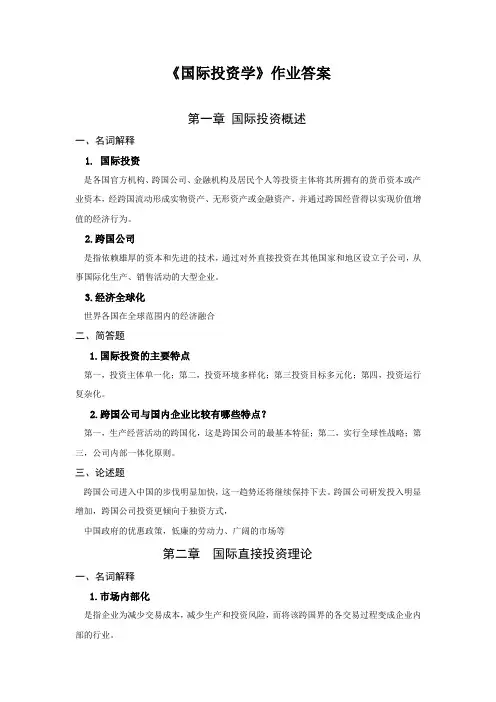
《国际投资学》作业答案第一章国际投资概述一、名词解释1. 国际投资是各国官方机构、跨国公司、金融机构及居民个人等投资主体将其所拥有的货币资本或产业资本,经跨国流动形成实物资产、无形资产或金融资产,并通过跨国经营得以实现价值增值的经济行为。
2.跨国公司是指依赖雄厚的资本和先进的技术,通过对外直接投资在其他国家和地区设立子公司,从事国际化生产、销售活动的大型企业。
3.经济全球化世界各国在全球范围内的经济融合二、简答题1.国际投资的主要特点第一,投资主体单一化;第二,投资环境多样化;第三投资目标多元化;第四,投资运行复杂化。
2.跨国公司与国内企业比较有哪些特点?第一,生产经营活动的跨国化,这是跨国公司的最基本特征;第二,实行全球性战略;第三,公司内部一体化原则。
三、论述题跨国公司进入中国的步伐明显加快,这一趋势还将继续保持下去。
跨国公司研发投入明显增加,跨国公司投资更倾向于独资方式,中国政府的优惠政策,低廉的劳动力、广阔的市场等第二章国际直接投资理论一、名词解释1.市场内部化是指企业为减少交易成本,减少生产和投资风险,而将该跨国界的各交易过程变成企业内部的行业。
2.产品生命周期是产品的市场寿命,即一种新产品从开始进入市场到被市场淘汰的整个过程3.区位优势是指跨国公司在投资区位上具有的选择优势二、简答题1.简述垄断优势理论的主要内容这一理论主要是回答一家外国企业的分支机构为什么能够与当地企业进行有效的竞争,并能长期生存和发展下去。
海默认为,一个企业之所以要对外直接投资,是因为它有比东道国同类企业有利的垄断优势,从而在国外进行生产可以赚取更多的利润。
这种垄断优势可以划分为两类:一类是包括生产技术、管理与组织技能及销售技能等一切无形资产在内的知识资产优势;一类是由于企业规模大而产生的规模经济优势。
2.国际生产折中论的主要内容对外投资主要是由所有权优势、内部化优势和区位优势这三个基本因素决定的。
邓宁认为决定对外直接投资的三项因素之间是相互关联、紧密联系的。
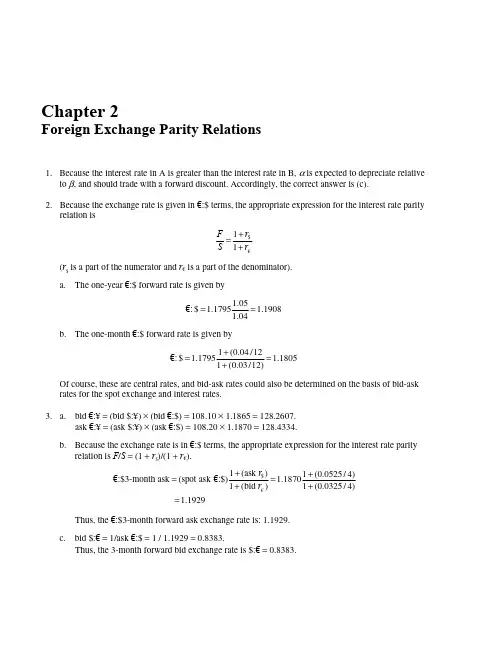
Chapter 2Foreign Exchange Parity Relations1. Because the interest rate in A is greater than the interest rate in B, α is expected to depreciate relativeto β, and should trade with a forward discount. Accordingly, the correct answer is (c).2. Because the exchange rate is given in €:$ terms, the appropriate expression for the interest rate parity relation is€+=+$11r F S r (r $ is a part of the numerator and r € is a part of the denominator).a. The one-year €:$ forward rate is given by €:==1.05$ 1.1795 1.19081.04b. The one-month €:$ forward rate is given by€:+==+1(0.04/12$ 1.1795 1.18051(0.03/12)Of course, these are central rates, and bid-ask rates could also be determined on the basis of bid-askrates for the spot exchange and interest rates.3. a. bid €:¥ = (bid $:¥) × (bid €:$) = 108.10 × 1.1865 = 128.2607.ask €:¥ = (ask $:¥) × (ask €:$) = 108.20 × 1.1870 = 128.4334.b. Because the exchange rate is in €:$ terms, the appropriate expression for the interest rate parityrelation is F /S = (1 + r $)/(1 + r €).€€€++==++=$1(ask )1(0.0525/4):$3-month ask (spot ask :$)1.18701(bid )1(0.0325/4)1.1929r rThus, the €:$3-month forward ask exchange rate is: 1.1929.c. bid $:€ = 1/ask €:$ = 1 / 1.1929 = 0.8383.Thus, the 3-month forward bid exchange rate is $:€ = 0.8383.Chapter 2 Foreign Exchange Parity Relations 7d. Because the exchange rate is in $:¥ terms, the appropriate expression for the interest rate parityrelation is F /S = (1 + r ¥ )/1 + r $.$++===+¥1(bid )1(0.0125/4)$:¥3-month bid (spot ask $:¥)108.10107.031(ask )(0.0325/4)r r $++===+¥1(ask )1(0.0150/4)$:¥3-month ask (spot ask $:¥)108.20107.261(bid )(0.0500/4)r rThus, the $:¥ 3-month forward exchange rate is: 107.03 – 107.26. Note : The interest rates one uses in all such computations are those that result in a lower forwardbid (so, bid interest rates in the numerator and ask rates in the denominator) and a higher forward ask (so, ask interest rates in the numerator and bid rates in the denominator).4. a. For six months, r SFr = 1.50% and r $ = 1.75%. Because the exchange rate is in $:SFr terms, the appropriate expression for the interest rate parity relation isSFr $SFr $1,or (1)(1)1r F F r r S r S+=+=++ The left side of this expression is$ 1.6558(1)(10.0175) 1.01331.6627F r S+=+= The right side of the expression is: 1 + r SFr = 1.0150. Because the left and right sides are not equal, IRP is not holding.b. Because IRP is not holding, there is an arbitrage possibility: Because 1.0133 < 1.0150, we cansay that the SFr interest rate quote is more than what it should be as per the quotes for the otherthree variables. Equivalently, we can also say that the $ interest rate quote is less than what itshould be as per the quotes for the other three variables. Therefore, the arbitrage strategy shouldbe based on borrowing in the $ market and lending in the SFr market. The steps would be asfollows:• Borrow $1,000,000 for six months at 3.5% per year. Need to pay back $1,000,000 ×(1 + 0.0175) = $1,017,500 six months later.• Convert $1,000,000 to SFr at the spot rate to get SFr 1,662,700.• Lend SFr 1,662,700 for six months at 3% per year. Will get back SFr 1,662,700 ×(1 + 0.0150) = SFr 1,687,641 six months later.• Sell SFr 1,687,641 six months forward. The transaction will be contracted as of the current date but delivery and settlement will only take place six months later. So, six months later,exchange SFr 1,687,641 for SFr 1,687,641/SFr 1.6558/$ = $1,019,230.The arbitrage profit six months later is 1,019,230 – 1,017,500 = $1,730.5. a. For three months, r $ = 1.30% and r ¥ = 0.30%. Because the exchange rate is in $:¥ terms, the appropriate expression for the interest rate parity relation is¥$¥$1,or (1)(1)1r F F r r S r S+=+=++8 Solnik/McLeavey • Global Investments, Sixth EditionThe left side of this expression is$107.30(1)(10.0130) 1.0064.108.00F r S+=+= The right side of this expression is: 1 + r ¥ = 1.0030. Because the left and right sides are not equal, IRP is not holding.b. Because IRP is not holding, there is an arbitrage possibility. Because 1.0064 > 1.0030, we cansay that the $ interest rate quote is more than what it should be as per the quotes for the otherthree variables. Equivalently, we can also say that the ¥ interest rate quote is less than what itshould be as per the quotes for the other three variables. Therefore, the arbitrage strategy shouldbe based on lending in the $ market and borrowing in the ¥ market. The steps would be asfollows:• Borrow the yen equivalent of $1,000,000. Because the spot rate is ¥108 per $, borrow$1,000,000 × ¥108/$ = ¥108,000,000. Need to pay back ¥108,000,000 × (1 + 0.0030) =¥108,324,000 three months later.• Exchange ¥108,000,000 for $1,000,000 at the spot exchange rate.• Lend $1,000,000 for three months at 5.20% per year. Will get back $1,000,000 ×(1 + 0.0130) = $1,013,000 three months later.• Buy ¥108,324,000 three months forward. The transaction will be contracted as of the current date, but delivery and settlement will only take place three months later. So, three monthslater, get ¥108,324,000 for ¥108,324,000 / (¥107.30 per $) = $1,009,543.The arbitrage profit three months later is 1,013,000 – 1,009,543 = $3,457.6. At the given exchange rate of 5 pesos/$, the cost in Mexico in dollar terms is $16 for shoes, $36 forwatches, and $120 for electric motors. Thus, compared with the United States, shoes and watches are cheaper in Mexico, and electric motors are more expensive in Mexico. Therefore, Mexico will import electric motors from the United States, and the United States will import shoes and watches from Mexico. Accordingly, the correct answer is (d).7. Consider two countries, A and B. Based on relative PPP,+=+1011A BS I S I where S 1 and S 0 are the expected and the current exchange rates between the currencies of A and B, and I A and I B are the inflation rates in A and B. If A and B belong to the group of countries thatintroduces the same currency, then one could think of both S 1 and S 0 being one. Then, I A and I B should both be equal for relative PPP to hold. Thus, introduction of a common currency by a group ofcountries would result in the convergence of the inflation rates among these countries. A similarargument could be applied to inflation among the various states of the United States.8. Based on relative PPP,+=+Switzerland 10US11I S S IChapter 2 Foreign Exchange Parity Relations 9where S 1 is the expected $:SFr exchange rate one year from now, S 0 is the current $:SFr exchange rate, and I Switzerland and I US are the expected annual inflation rates in Switzerland and the United States, respectively. So,1110.02and 1.60(1.02/1.05)SFr 1.55/$.1.6010.05S S +===+ 9. a. A Japanese consumption basket consists of two-thirds sake and one-third TV sets. The price ofsake in yen is rising at a rate of 10% per year. The price of TV sets is constant. The Japanese consumer price index inflation is therefore equal to+=21(10%)(0%) 6.67%33b. Relative PPP states thatFC 10DC1.1I S S I +=+ Because the exchange rate is given to be constant, we have S 0 = S 1, which implies S 1/S 0 = 1. As a result, in our example, PPP would hold if 1 + I FC = 1 + I DC (i.e., I FC = I DC ). Because the Japanese inflation rate is 6.67% and the American inflation rate is 0%, we do not have I FC = I DC , and PPP does not hold.10. a. i. The law of one price is that, assuming competitive markets and no transportation costs ortariffs, the same goods should have the same real prices in all countries after convertingprices to a common currency.ii. Absolute PPP, focusing on baskets of goods and services, states that the same basket ofgoods should have the same price in all countries after conversion to a common currency.Under absolute PPP, the equilibrium exchange rate between two currencies would be the ratethat equalizes the prices of a basket of goods between the two countries. This rate wouldcorrespond to the ratio of average price levels in the countries. Absolute PPP assumes noimpediments to trade and identical price indexes that do not create measurement problems.iii. Relative PPP holds that exchange rate movements reflect differences in price changes(inflation rates) between countries. A country with a relatively high inflation rate willexperience a proportionate depreciation of its currency’s value vis-à-vis that of a countrywith a lower rate of inflation. Movements in currencies provide a means for maintainingequivalent purchasing power levels among currencies in the presence of differing inflationrates.Relative PPP assumes that prices adjust quickly and price indexes properly measure inflationrates. Because relative PPP focuses on changes and not absolute levels, relative PPP is morelikely to be satisfied than the law of one price or absolute PPP.b. i. Relative PPP is not consistently useful in the short run because of the following:(1) Relationships between month-to-month movements in market exchange rates and PPPare not consistently strong, according to empirical research. Deviations between the ratescan persist for extended periods. (2) Exchange rates fluctuate minute by minute becausethey are set in the financial markets. Price levels, in contrast, are sticky and adjust slowly.(3) Many other factors can influence exchange rate movements rather than just inflation.ii. Research suggests that over the long term, a tendency exists for market and PPP rates tomove together, with market rates eventually moving toward levels implied by PPP.10 Solnik/McLeavey • Global Investments, Sixth Edition11. a. If the treasurer is worried that the franc might appreciate in the next three months, she couldhedge her foreign exchange exposure by trading this risk against the premium included in theforward exchange rate. She could buy 10 million Swiss francs on the three-month forward market at the rate of SFr 1.5320 per €. The transaction will be contracted as of the current date, butdelivery and settlement will only take place three months later.b. Three months later, the company received the 10 million Swiss francs at the forward rate ofSFr 1.5320 per € agreed on earlier. Thus, the company needed (SFr 10,000,000)/(SFr 1.5320per €), or €6,527,415. If the company had not entered into a forward contract, the companywould have received the 10 million Swiss francs at the spot rate of SFr 1.5101 per €. Thus, thecompany would have needed (SFr 10,000,000) / (SFr 1.5101 per €), or €6,622,078. Therefore,the company benefited by the treasurer’s action, because €6,622,078 – €6,527,415 = €94,663were saved.12. The nominal interest rate is approximately the sum of the real interest rate and the expected inflationrate over the term of the interest rate. Even if the international Fisher relation holds, and the realinterest rates are equal among countries, the expected inflation can be very different from one country to another. Therefore, there is no reason why nominal interest rates should be equal among countries.13. Because the Australian dollar is expected to depreciate relative to the dollar, we know from thecombination of international Fisher relation and relative PPP that the nominal interest rate inAustralia is greater than the nominal interest rate in the United States. Further, the nominal interest rate in the United States is greater than that in Switzerland. Thus, the nominal interest rate inAustralia has to be greater than the nominal interest rate in Switzerland. Therefore, we can say from the combination of international Fisher relation and relative PPP that the Australian dollar is expected to depreciate relative to the Swiss franc.14. According to the approximate version of the international Fisher relation, r Sweden − r US = I Sweden − I US . So, 8 − 7 = 6 − I US , which means that I US = 5%.According to the approximate version of relative PPP,−=−10Sweden US 0S S I I S where, S 1 and S 0 are in $:SKr terms. I Sweden − I U S = 6 − 5 = 1%, or 0.01. So, (6 − S 0)/S 0 = 0.01. Solving for S 0, we get S 0 = SKr 5.94 per $.According to the approximate version of IRP,−=−0Sweden US 0F S r r S where, F and S 0 are in $:SKr terms. r Sweden − r US = 8 − 7 = 1%, or 0.01. So, (F − 5.94)/5.94 = 0.01. Solving for F , we get F = SKr 6 per $.Because we are given the expected exchange rate, we could also have arrived at this answer by usingthe foreign exchange expectations relation.Chapter 2 Foreign Exchange Parity Relations 1115. According to the international Fisher relation,++=++Switzerland Switzerland UK UK1111r I r I So,++=++Switzerland 110.0410.1210.10r therefore, r Switzerland = 0.0589, or 5.89%.According to relative PPP,+=+Switzerland 10UK11I S S I where, S 1 and S 0 are in £:SFr terms.So,110.04.310.10S +=+ Solving for S 1 we get S 1 = SFr 2.8364 per £.According to IRP,+=+Switzerland 0UK11r F S r where, F and S 0 are in £:SFr terms.So,10.0589.310.12F +=+ Solving for F , we get F = SFr 2.8363 per £. This is the same as the expected exchange rate in oneyear, with the slight difference due to rounding.16. During the 1991–1996 period, the cumulative inflation rates were about 25 percent in Malaysia,61 percent in the Philippines, and 18 percent in the United States. Over this period, based on relative PPP, one would have expected the Malaysian ringgit to depreciate by about 7 percent relative to the United States dollar (the inflation differential). In reality, the Malaysian ringgit appreciated by about 8 percent. Similarly, in view of the very high inflation differential between the Philippines and the United States, one would have expected the Philippine peso to depreciate considerably relative to the dollar. But it did not. Thus, according to PPP, both currencies had become strongly overvalued.12 Solnik/McLeavey • Global Investments, Sixth Edition17. a. According to PPP, the current exchange rate should bePif Pif 1010$$10//PI PI S S PI PI == where subscript 1 refers to the value now, subscript 0 refers to the value 20 years ago, PI refers toprice index, and S is the $:pif exchange rate. Thus, the current exchange rate based on PPP should be1200/1002pif 1 per $.400/100S ⎛⎞==⎜⎟⎝⎠b. As per PPP, the pif is overvalued at the prevailing exchange rate of pif 0.9 per $.18. Exports equal 10 million pifs and imports equal $7 million (6.3 million pifs). Accordingly, the tradebalance is 10 − 6.3 = 3.7 million pifs.• Balance of services includes the $0.5 million spent by tourists (0.45 million pifs).• Net income includes $0.1 million or 0.09 million pifs received by Paf investors as dividends,minus 1 million pifs paid out by Paf as interest on Paf bonds (− 0.91 million pifs).• Unrequited transfers include $0.3 million (0.27 million pifs) received by Paf as foreign aid.• Portfolio investment includes the $3 million or 2.7 million pifs spent by Paf investors to buyforeign firms. So, portfolio investment = −2.7 million pifs.Based on the preceding,• Current account = 3.24 (= 3.70 + 0.45 − 0.91)• Capital account = 0.27• Financial account = −2.7The sum of current account, capital account, and financial account is 0.81. By definition of balance ofpayments, the sum of the current account, the capital account, the financial account, and the change in official reserves must be equal to zero. Therefore, official reserve account = −0.81.The following summarizes the effect of the transactions on the balance of payments.Current account 3.24Trade balance 3.70Balance of services 0.45Net income – 0.91Capital account 0.27Unrequited transfers 0.27Financial account – 2.70Portfolio investment – 2.70Official reserve account – 0.8119. a. A traditional flow market approach would suggest that the home currency should depreciatebecause of increased inflation. An increase in domestic consumption could also lead to increased imports and a deficit in the balance of trade. This deficit should lead to a weakening of the homecurrency in the short run.b. The asset market approach claims that this scenario is good for the home currency. Foreigncapital investment is attracted by the high returns caused by economic growth and high interestrates. This capital inflow leads to an appreciation of the home currency.Chapter 2 Foreign Exchange Parity Relations 13 20. a. i. The immediate effect of reducing the budget deficit is to reduce the demand for loanablefunds because the government needs to borrow less to bridge the gap between spending andtaxes.ii. The reduced public-sector demand for loanable funds has the direct effect of lowering nominal interest rates, because lower demand leads to lower cost of borrowing, iii. The direct effect of the budget deficit reduction is a depreciation of the domestic currency and the exchange rate. As investors sell lower yielding Country M securities to buy thesecurities of other countries, Country M’s currency will come under pressure andCountry M’s currency will depreciate.b. i. In the case of a credible, sustainable, and large reduction in the budget deficit, reducedinflationary expectations are likely because the central bank is less likely to monetize thedebt by increasing the money supply. Purchasing power parity and international Fisherrelationships suggest that a currency should strengthen against other currencies whenexpected inflation declines.ii. A reduction in government spending would tend to shift resources into private-sector investments, in which productivity is higher. The effect would be to increase the expectedreturn on domestic securities.。
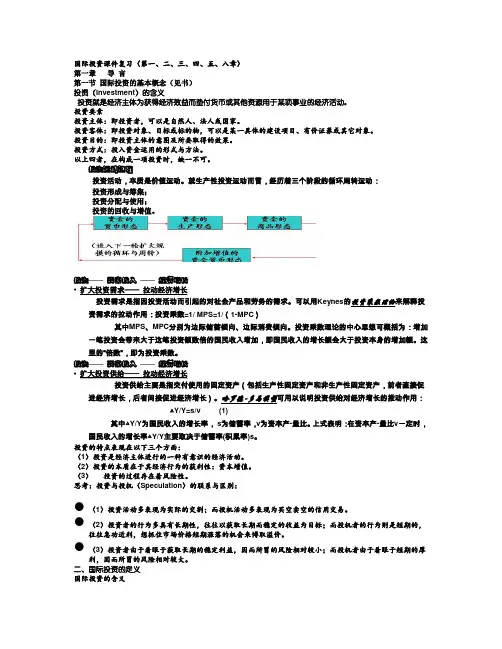
国际投资课件复习(第一、二、三、四、五、八章)第一章导言第一节国际投资的基本概念(见书)投资(Investment)的含义投资就是经济主体为获得经济效益而垫付货币或其他资源用于某项事业的经济活动。
投资要素投资主体:即投资者,可以是自然人、法人或国家。
投资客体:即投资对象、目标或标的物,可以是某一具体的建设项目、有价证券或其它对象。
投资目的:即投资主体的意图及所要取得的效果。
投资方式:投入资金运用的形式与方法。
以上四者,在构成一项投资时,缺一不可。
投资运动过程投资活动,本质是价值运动。
就生产性投资运动而言,经历着三个阶段的循环周转运动:投资形成与筹集;投资分配与使用;投资的回收与增值。
投资——要素投入——经济增长•扩大投资需求——拉动经济增长投资需求是指因投资活动而引起的对社会产品和劳务的需求。
可以用Keynes的投资乘数理论来解释投资需求的拉动作用:投资乘数=1/ MPS=1/(1-MPC)其中MPS、MPC分别为边际储蓄倾向、边际消费倾向。
投资乘数理论的中心思想可概括为:增加一笔投资会带来大于这笔投资额数倍的国民收入增加,即国民收入的增长额会大于投资本身的增加额。
这里的“倍数”,即为投资乘数。
投资——要素投入——经济增长•扩大投资供给——拉动经济增长投资供给主要是指交付使用的固定资产(包括生产性固定资产和非生产性固定资产,前者直接促进经济增长,后者间接促进经济增长)。
哈罗德-多马模型可用以说明投资供给对经济增长的推动作用:△Y/Y=s/v (1)其中△Y/Y为国民收入的增长率,s为储蓄率,v为资本产-量比。
上式表明:在资本产-量比v一定时,国民收入的增长率△Y/Y主要取决于储蓄率(积累率)s。
投资的特点表现在以下三个方面:(1)投资是经济主体进行的一种有意识的经济活动。
(2)投资的本质在于其经济行为的获利性:资本增值。
(3)投资的过程存在着风险性。
思考:投资与投机(Speculation)的联系与区别:●(1)投资活动多表现为实际的交割;而投机活动多表现为买空卖空的信用交易。
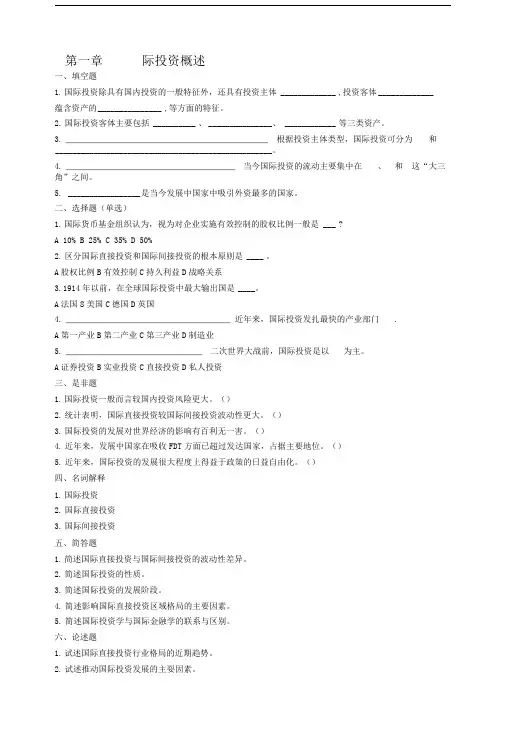
第一章际投资概述一、填空题1.国际投资除具有国内投资的一般特征外,还具有投资主体 _____________ ,投资客体_____________蕴含资产的_______________ ,等方面的特征。
2.国际投资客体主要包括 __________ 、_______________ 、 ____________ 等三类资产。
3. ___________________________________________ 根据投资主体类型,国际投资可分为和___________________________________________________ 。
4. ____________________________________ 当今国际投资的流动主要集中在、和这“大三角”之间。
5. _________________ 是当今发展中国家中吸引外资最多的国家。
二、选择题(单选)1.国际货币基金组织认为,视为对企业实施有效控制的股权比例一般是 ___ ?A 10%B 25%C 35%D 50%2.区分国际直接投资和国际间接投资的根本原则是 ____ 。
A股权比例B有效控制C持久利益D战略关系3.1914年以前,在全球国际投资中最大输出国是____ 。
A法国8美国C德国D英国4. ___________________________________ 近年来,国际投资发扎最快的产业部门.A第一产业B第二产业C第三产业D制造业5. _____________________________ 二次世界大战前,国际投资是以为主。
A证券投资B实业投资C直接投资D私人投资三、是非题1.国际投资一般而言较国内投资风险更大。
()2.统计表明,国际直接投资较国际间接投资波动性更大。
()3.国际投资的发展对世界经济的影响有百利无一害。
()4.近年来,发展中国家在吸收FDT方面已超过发达国家,占据主要地位。
()5.近年来,国际投资的发展很大程度上得益于政策的日益自由化。
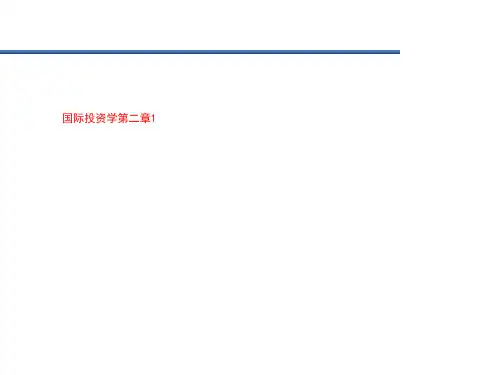
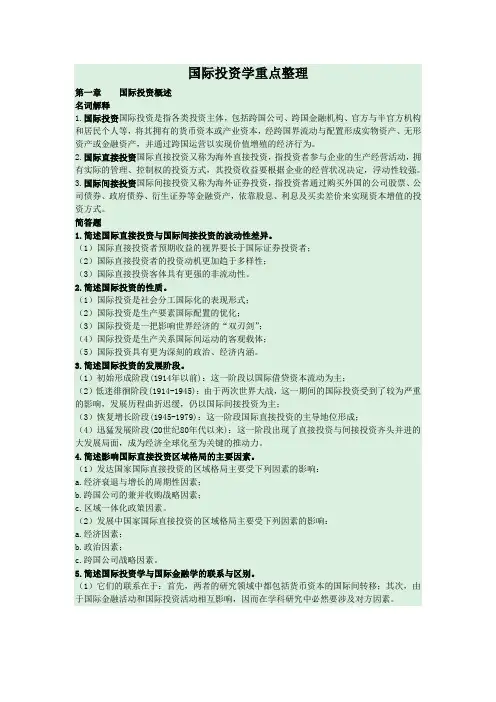
国际投资学重点整理第一章国际投资概述名词解释1.国际投资国际投资是指各类投资主体,包括跨国公司、跨国金融机构、官方与半官方机构和居民个人等,将其拥有的货币资本或产业资本,经跨国界流动与配置形成实物资产、无形资产或金融资产,并通过跨国运营以实现价值增殖的经济行为。
2.国际直接投资国际直接投资又称为海外直接投资,指投资者参与企业的生产经营活动,拥有实际的管理、控制权的投资方式,其投资收益要根据企业的经营状况决定,浮动性较强。
3.国际间接投资国际间接投资又称为海外证券投资,指投资者通过购买外国的公司股票、公司债券、政府债券、衍生证券等金融资产,依靠股息、利息及买卖差价来实现资本增值的投资方式。
简答题1.简述国际直接投资与国际间接投资的波动性差异。
(1)国际直接投资者预期收益的视界要长于国际证券投资者;(2)国际直接投资者的投资动机更加趋于多样性;(3)国际直接投资客体具有更强的非流动性。
2.简述国际投资的性质。
(1)国际投资是社会分工国际化的表现形式;(2)国际投资是生产要素国际配置的优化;(3)国际投资是一把影响世界经济的“双刃剑”;(4)国际投资是生产关系国际间运动的客观载体;(5)国际投资具有更为深刻的政治、经济内涵。
3.简述国际投资的发展阶段。
(1)初始形成阶段(1914年以前):这一阶段以国际借贷资本流动为主;(2)低迷徘徊阶段(1914-1945):由于两次世界大战,这一期间的国际投资受到了较为严重的影响,发展历程曲折迟缓,仍以国际间接投资为主;(3)恢复增长阶段(1945-1979):这一阶段国际直接投资的主导地位形成;(4)迅猛发展阶段(20世纪80年代以来):这一阶段出现了直接投资与间接投资齐头并进的大发展局面,成为经济全球化至为关键的推动力。
4.简述影响国际直接投资区域格局的主要因素。
(1)发达国家国际直接投资的区域格局主要受下列因素的影响:a.经济衰退与增长的周期性因素;b.跨国公司的兼并收购战略因素;c.区域一体化政策因素。
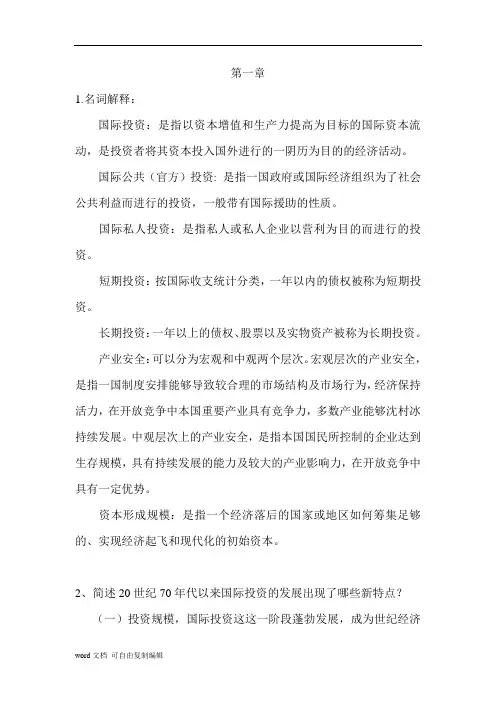
第一章1.名词解释:国际投资:是指以资本增值和生产力提高为目标的国际资本流动,是投资者将其资本投入国外进行的一阴历为目的的经济活动。
国际公共(官方)投资: 是指一国政府或国际经济组织为了社会公共利益而进行的投资,一般带有国际援助的性质。
国际私人投资:是指私人或私人企业以营利为目的而进行的投资。
短期投资:按国际收支统计分类,一年以内的债权被称为短期投资。
长期投资:一年以上的债权、股票以及实物资产被称为长期投资。
产业安全:可以分为宏观和中观两个层次。
宏观层次的产业安全,是指一国制度安排能够导致较合理的市场结构及市场行为,经济保持活力,在开放竞争中本国重要产业具有竞争力,多数产业能够沈村冰持续发展。
中观层次上的产业安全,是指本国国民所控制的企业达到生存规模,具有持续发展的能力及较大的产业影响力,在开放竞争中具有一定优势。
资本形成规模:是指一个经济落后的国家或地区如何筹集足够的、实现经济起飞和现代化的初始资本。
2、简述20世纪70年代以来国际投资的发展出现了哪些新特点?(一)投资规模,国际投资这这一阶段蓬勃发展,成为世纪经济舞台最为活跃的角色。
国际直接投资成为了国际经济联系中更主要的载体。
(二)投资格局,1.“大三角”国家对外投资集聚化2.发达国家之间的相互投资不断增加 3.发展中国家在吸引外资的同时,也走上了对外投资的舞台(三)投资方式,国际投资的发展出现了直接投资与间接投资齐头并进的发展局面。
(四)投资行业,第二次世界大战后,国际直接投资的行业重点进一步转向第二产业。
3.如何看待麦克杜格尔模型的基本理念?麦克杜格尔模型是麦克杜格尔在1960年提出来,后经肯普发展,用于分析国际资本流动的一般理论模型,其分析的是国际资本流动对资本输出国、资本输入国及整个世界生产和国民收入分配的影响。
麦克杜格尔和肯普认为,国际间不存在限制资本流动的因素,资本可以自由地从资本要素丰富的国家流向资本要素短缺的国家。
资本流动的原因在于前者的资本价格低于后者。
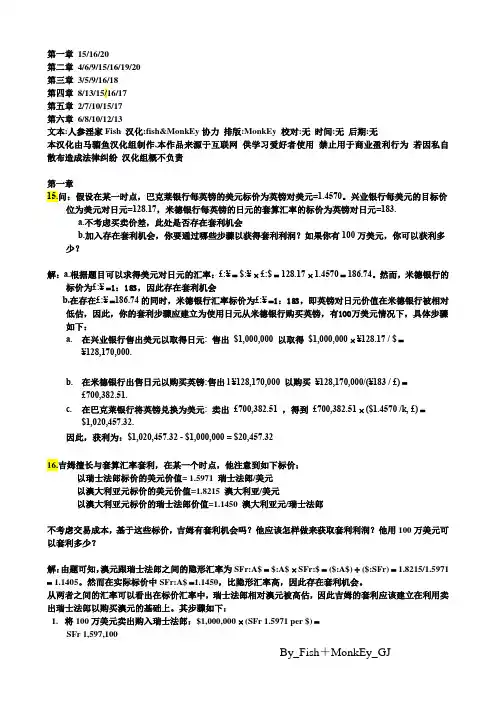
第一章15/16/20第二章4/6/9/15/16/19/20第三章3/5/9/16/18第四章8/13/15/16/17第五章2/7/10/15/17第六章6/8/10/12/13文本:人参淫家Fish 汉化:fish&MonkEy协力排版:MonkEy 校对:无时间:无后期:无本汉化由马骝鱼汉化组制作,本作品来源于互联网供学习爱好者使用禁止用于商业盈利行为若因私自散布造成法律纠纷汉化组概不负责第一章15.问:假设在某一时点,巴克莱银行每英镑的美元标价为英镑对美元=1.4570。
兴业银行每美元的目标价位为美元对日元=128.17,米德银行每英镑的日元的套算汇率的标价为英镑对日元=183.a.不考虑买卖价差,此处是否存在套利机会b.加入存在套利机会,你要通过哪些步骤以获得套利利润?如果你有100万美元,你可以获利多少?解:a.根据题目可以求得美元对日元的汇率:£:¥= $:¥⨯ £:$ = 128.17 ⨯ 1.4570 = 186.74。
然而,米德银行的标价为£:¥=1:183,因此存在套利机会b.在存在£:¥=186.74的同时,米德银行汇率标价为£:¥=1:183,即英镑对日元价值在米德银行被相对低估,因此,你的套利步骤应建立为使用日元从米德银行购买英镑,有100万美元情况下,具体步骤如下:a. 在兴业银行售出美元以取得日元: 售出$1,000,000 以取得$1,000,000 ⨯ ¥128.17 / $ =¥128,170,000.b. 在米德银行出售日元以购买英镑:售出l ¥128,170,000 以购买¥128,170,000/(¥183 / £) =£700,382.51.c. 在巴克莱银行将英镑兑换为美元: 卖出£700,382.51 ,得到£700,382.51 ⨯ ($1.4570 /k, £) =$1,020,457.32.因此,获利为:$1,020,457.32 - $1,000,000 = $20,457.3216.吉姆擅长与套算汇率套利,在某一个时点,他注意到如下标价:以瑞士法郎标价的美元价值= 1.5971 瑞士法郎/美元以澳大利亚元标价的美元价值=1.8215 澳大利亚/美元以澳大利亚元标价的瑞士法郎价值=1.1450 澳大利亚元/瑞士法郎不考虑交易成本,基于这些标价,吉姆有套利机会吗?他应该怎样做来获取套利利润?他用100万美元可以套利多少?解:由题可知,澳元跟瑞士法郎之间的隐形汇率为SFr:A$ = $:A$ ⨯ SFr:$ = ($:A$) ÷ ($:SFr) = 1.8215/1.5971 = 1.1405。
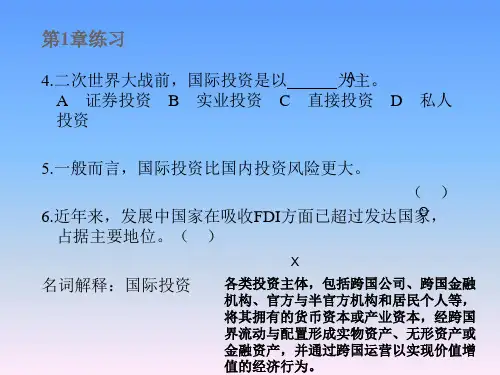
《国际投资学教程》(第四版)习题参考答案第一章 国际投资概述1.名词解释国际投资:是指以资本增值和生产力提高为目标的国际资本流动,是投资者将其资本投入国外进行的以盈利为目的的经济活动。
公共投资VS 私人投资:前者是指一国政府或国际经济组织为了社会公共利益而进行的投资,一般带有国际援助的性质;后者是指私人或私人企业以盈利为目的而进行的投资。
二者区分的关键点在于投资主体和投资目的。
长期投资VS 短期投资:二者区分的关键点在于时间,前者一年以上,后者一年之内。
产业安全:所谓产业安全,可以分为宏观和中观两个层次。
宏观层次的产业安全,是指一国制度安排能够导致较合理的市场结构及市场行为,经济保持活力,在开放竞争中本国重要产业具有竞争力,多数产业能够生存并持续发展。
中观层次上的产业安全,是指本国国民所控制的企业达到生存规模,具有持续发展的能力及较大的产业影响力,在开放竞争中具有一定优势。
资本形成规模:是指海外直接投资的进入通常会引致东道国资本存量的增加,并被认为是国际投资对东道国(尤其是发展中东道国)经济增长的重大贡献。
2.简述20世纪70年代以来国际投资的发展出现了哪些新特点?(1)投资规模:国际直接投资的增长率大大超过了同期世界总产值和世界出口的增长率,成为国际经济联系中更主要的载体。
(2)投资格局,三个要点:其一,“大三角”国家对外投资集聚化,即美国、日本和西欧三足鼎立的“大三角”国际投资格局得以形成。
不仅如此,“大三角”国家和发展中国家相比,在对外投资领域显示出绝对主导地位。
其二,发达国家之间的相互投资不断增加。
不仅在国际资本流动中占据2/3的比重,成为国际投资的主体,而且在全球直接投资中占有更加重要的地位,形成了明显的以德国为中心的欧盟圈、以美国为中心的北美圈和以日本为中心的亚洲圈,占据了发达国家之间资本输入的绝大部分。
其三,发展中国家在吸引外资的同时,也走上了对外投资的舞台。
(3)投资方式:20世纪80年代以来,国际投资的发展出现了直接投资与间接投资齐头并进的发展局面。
第一章1.名词解释:国际投资:是指以资本增值和生产力提高为目标的国际资本流动,是投资者将其资本投入国外进行的一阴历为目的的经济活动。
国际公共(官方)投资: 是指一国政府或国际经济组织为了社会公共利益而进行的投资,一般带有国际援助的性质。
国际私人投资:是指私人或私人企业以营利为目的而进行的投资。
短期投资:按国际收支统计分类,一年以内的债权被称为短期投资。
长期投资:一年以上的债权、股票以及实物资产被称为长期投资。
产业安全:可以分为宏观和中观两个层次。
宏观层次的产业安全,是指一国制度安排能够导致较合理的市场结构及市场行为,经济保持活力,在开放竞争中本国重要产业具有竞争力,多数产业能够沈村冰持续发展。
中观层次上的产业安全,是指本国国民所控制的企业达到生存规模,具有持续发展的能力及较大的产业影响力,在开放竞争中具有一定优势。
资本形成规模:是指一个经济落后的国家或地区如何筹集足够的、实现经济起飞和现代化的初始资本。
2、简述20世纪70年代以来国际投资的发展出现了哪些新特点?(一)投资规模,国际投资这这一阶段蓬勃发展,成为世纪经济舞台最为活跃的角色。
国际直接投资成为了国际经济联系中更主要的载体。
(二)投资格局,1.“大三角”国家对外投资集聚化 2.发达国家之间的相互投资不断增加 3.发展中国家在吸引外资的同时,也走上了对外投资的舞台(三)投资方式,国际投资的发展出现了直接投资与间接投资齐头并进的发展局面。
(四)投资行业,第二次世界大战后,国际直接投资的行业重点进一步转向第二产业。
3.如何看待麦克杜格尔模型的基本理念?麦克杜格尔模型是麦克杜格尔在1960年提出来,后经肯普发展,用于分析国际资本流动的一般理论模型,其分析的是国际资本流动对资本输出国、资本输入国及整个世界生产和国民收入分配的影响。
麦克杜格尔和肯普认为,国际间不存在限制资本流动的因素,资本可以自由地从资本要素丰富的国家流向资本要素短缺的国家。
资本流动的原因在于前者的资本价格低于后者。
Chapter 2Foreign Exchange Parity Relations1. Because the interest rate in A is greater than the interest rate in B, α is expected to depreciate relativeto β, and should trade with a forward discount. Accordingly, the correct answer is (c).2. Because the exchange rate is given in €:$ terms, the appropriate expression for the interest rate parity relation is€+=+$11r F S r (r $ is a part of the numerator and r € is a part of the denominator).a. The one-year €:$ forward rate is given by €:==1.05$ 1.1795 1.19081.04b. The one-month €:$ forward rate is given by€:+==+1(0.04/12$ 1.1795 1.18051(0.03/12)Of course, these are central rates, and bid-ask rates could also be determined on the basis of bid-askrates for the spot exchange and interest rates.3. a. bid €:¥ = (bid $:¥) × (bid €:$) = 108.10 × 1.1865 = 128.2607.ask €:¥ = (ask $:¥) × (ask €:$) = 108.20 × 1.1870 = 128.4334.b. Because the exchange rate is in €:$ terms, the appropriate expression for the interest rate parityrelation is F /S = (1 + r $)/(1 + r €).€€€++==++=$1(ask )1(0.0525/4):$3-month ask (spot ask :$)1.18701(bid )1(0.0325/4)1.1929r rThus, the €:$3-month forward ask exchange rate is: 1.1929.c. bid $:€ = 1/ask €:$ = 1 / 1.1929 = 0.8383.Thus, the 3-month forward bid exchange rate is $:€ = 0.8383.Chapter 2 Foreign Exchange Parity Relations 7d. Because the exchange rate is in $:¥ terms, the appropriate expression for the interest rate parityrelation is F /S = (1 + r ¥ )/1 + r $.$++===+¥1(bid )1(0.0125/4)$:¥3-month bid (spot ask $:¥)108.10107.031(ask )(0.0325/4)r r $++===+¥1(ask )1(0.0150/4)$:¥3-month ask (spot ask $:¥)108.20107.261(bid )(0.0500/4)r rThus, the $:¥ 3-month forward exchange rate is: 107.03 – 107.26. Note : The interest rates one uses in all such computations are those that result in a lower forwardbid (so, bid interest rates in the numerator and ask rates in the denominator) and a higher forward ask (so, ask interest rates in the numerator and bid rates in the denominator).4. a. For six months, r SFr = 1.50% and r $ = 1.75%. Because the exchange rate is in $:SFr terms, the appropriate expression for the interest rate parity relation isSFr $SFr $1,or (1)(1)1r F F r r S r S+=+=++ The left side of this expression is$ 1.6558(1)(10.0175) 1.01331.6627F r S+=+= The right side of the expression is: 1 + r SFr = 1.0150. Because the left and right sides are not equal, IRP is not holding.b. Because IRP is not holding, there is an arbitrage possibility: Because 1.0133 < 1.0150, we cansay that the SFr interest rate quote is more than what it should be as per the quotes for the otherthree variables. Equivalently, we can also say that the $ interest rate quote is less than what itshould be as per the quotes for the other three variables. Therefore, the arbitrage strategy shouldbe based on borrowing in the $ market and lending in the SFr market. The steps would be asfollows:• Borrow $1,000,000 for six months at 3.5% per year. Need to pay back $1,000,000 ×(1 + 0.0175) = $1,017,500 six months later.• Convert $1,000,000 to SFr at the spot rate to get SFr 1,662,700.• Lend SFr 1,662,700 for six months at 3% per year. Will get back SFr 1,662,700 ×(1 + 0.0150) = SFr 1,687,641 six months later.• Sell SFr 1,687,641 six months forward. The transaction will be contracted as of the current date but delivery and settlement will only take place six months later. So, six months later,exchange SFr 1,687,641 for SFr 1,687,641/SFr 1.6558/$ = $1,019,230.The arbitrage profit six months later is 1,019,230 – 1,017,500 = $1,730.5. a. For three months, r $ = 1.30% and r ¥ = 0.30%. Because the exchange rate is in $:¥ terms, the appropriate expression for the interest rate parity relation is¥$¥$1,or (1)(1)1r F F r r S r S+=+=++8 Solnik/McLeavey • Global Investments, Sixth EditionThe left side of this expression is$107.30(1)(10.0130) 1.0064.108.00F r S+=+= The right side of this expression is: 1 + r ¥ = 1.0030. Because the left and right sides are not equal, IRP is not holding.b. Because IRP is not holding, there is an arbitrage possibility. Because 1.0064 > 1.0030, we cansay that the $ interest rate quote is more than what it should be as per the quotes for the otherthree variables. Equivalently, we can also say that the ¥ interest rate quote is less than what itshould be as per the quotes for the other three variables. Therefore, the arbitrage strategy shouldbe based on lending in the $ market and borrowing in the ¥ market. The steps would be asfollows:• Borrow the yen equivalent of $1,000,000. Because the spot rate is ¥108 per $, borrow$1,000,000 × ¥108/$ = ¥108,000,000. Need to pay back ¥108,000,000 × (1 + 0.0030) =¥108,324,000 three months later.• Exchange ¥108,000,000 for $1,000,000 at the spot exchange rate.• Lend $1,000,000 for three months at 5.20% per year. Will get back $1,000,000 ×(1 + 0.0130) = $1,013,000 three months later.• Buy ¥108,324,000 three months forward. The transaction will be contracted as of the current date, but delivery and settlement will only take place three months later. So, three monthslater, get ¥108,324,000 for ¥108,324,000 / (¥107.30 per $) = $1,009,543.The arbitrage profit three months later is 1,013,000 – 1,009,543 = $3,457.6. At the given exchange rate of 5 pesos/$, the cost in Mexico in dollar terms is $16 for shoes, $36 forwatches, and $120 for electric motors. Thus, compared with the United States, shoes and watches are cheaper in Mexico, and electric motors are more expensive in Mexico. Therefore, Mexico will import electric motors from the United States, and the United States will import shoes and watches from Mexico. Accordingly, the correct answer is (d).7. Consider two countries, A and B. Based on relative PPP,+=+1011A BS I S I where S 1 and S 0 are the expected and the current exchange rates between the currencies of A and B, and I A and I B are the inflation rates in A and B. If A and B belong to the group of countries thatintroduces the same currency, then one could think of both S 1 and S 0 being one. Then, I A and I B should both be equal for relative PPP to hold. Thus, introduction of a common currency by a group ofcountries would result in the convergence of the inflation rates among these countries. A similarargument could be applied to inflation among the various states of the United States.8. Based on relative PPP,+=+Switzerland 10US11I S S IChapter 2 Foreign Exchange Parity Relations 9where S 1 is the expected $:SFr exchange rate one year from now, S 0 is the current $:SFr exchange rate, and I Switzerland and I US are the expected annual inflation rates in Switzerland and the United States, respectively. So,1110.02and 1.60(1.02/1.05)SFr 1.55/$.1.6010.05S S +===+ 9. a. A Japanese consumption basket consists of two-thirds sake and one-third TV sets. The price ofsake in yen is rising at a rate of 10% per year. The price of TV sets is constant. The Japanese consumer price index inflation is therefore equal to+=21(10%)(0%) 6.67%33b. Relative PPP states thatFC 10DC1.1I S S I +=+ Because the exchange rate is given to be constant, we have S 0 = S 1, which implies S 1/S 0 = 1. As a result, in our example, PPP would hold if 1 + I FC = 1 + I DC (i.e., I FC = I DC ). Because the Japanese inflation rate is 6.67% and the American inflation rate is 0%, we do not have I FC = I DC , and PPP does not hold.10. a. i. The law of one price is that, assuming competitive markets and no transportation costs ortariffs, the same goods should have the same real prices in all countries after convertingprices to a common currency.ii. Absolute PPP, focusing on baskets of goods and services, states that the same basket ofgoods should have the same price in all countries after conversion to a common currency.Under absolute PPP, the equilibrium exchange rate between two currencies would be the ratethat equalizes the prices of a basket of goods between the two countries. This rate wouldcorrespond to the ratio of average price levels in the countries. Absolute PPP assumes noimpediments to trade and identical price indexes that do not create measurement problems.iii. Relative PPP holds that exchange rate movements reflect differences in price changes(inflation rates) between countries. A country with a relatively high inflation rate willexperience a proportionate depreciation of its currency’s value vis-à-vis that of a countrywith a lower rate of inflation. Movements in currencies provide a means for maintainingequivalent purchasing power levels among currencies in the presence of differing inflationrates.Relative PPP assumes that prices adjust quickly and price indexes properly measure inflationrates. Because relative PPP focuses on changes and not absolute levels, relative PPP is morelikely to be satisfied than the law of one price or absolute PPP.b. i. Relative PPP is not consistently useful in the short run because of the following:(1) Relationships between month-to-month movements in market exchange rates and PPPare not consistently strong, according to empirical research. Deviations between the ratescan persist for extended periods. (2) Exchange rates fluctuate minute by minute becausethey are set in the financial markets. Price levels, in contrast, are sticky and adjust slowly.(3) Many other factors can influence exchange rate movements rather than just inflation.ii. Research suggests that over the long term, a tendency exists for market and PPP rates tomove together, with market rates eventually moving toward levels implied by PPP.10 Solnik/McLeavey • Global Investments, Sixth Edition11. a. If the treasurer is worried that the franc might appreciate in the next three months, she couldhedge her foreign exchange exposure by trading this risk against the premium included in theforward exchange rate. She could buy 10 million Swiss francs on the three-month forward market at the rate of SFr 1.5320 per €. The transaction will be contracted as of the current date, butdelivery and settlement will only take place three months later.b. Three months later, the company received the 10 million Swiss francs at the forward rate ofSFr 1.5320 per € agreed on earlier. Thus, the company needed (SFr 10,000,000)/(SFr 1.5320per €), or €6,527,415. If the company had not entered into a forward contract, the companywould have received the 10 million Swiss francs at the spot rate of SFr 1.5101 per €. Thus, thecompany would have needed (SFr 10,000,000) / (SFr 1.5101 per €), or €6,622,078. Therefore,the company benefited by the treasurer’s action, because €6,622,078 – €6,527,415 = €94,663were saved.12. The nominal interest rate is approximately the sum of the real interest rate and the expected inflationrate over the term of the interest rate. Even if the international Fisher relation holds, and the realinterest rates are equal among countries, the expected inflation can be very different from one country to another. Therefore, there is no reason why nominal interest rates should be equal among countries.13. Because the Australian dollar is expected to depreciate relative to the dollar, we know from thecombination of international Fisher relation and relative PPP that the nominal interest rate inAustralia is greater than the nominal interest rate in the United States. Further, the nominal interest rate in the United States is greater than that in Switzerland. Thus, the nominal interest rate inAustralia has to be greater than the nominal interest rate in Switzerland. Therefore, we can say from the combination of international Fisher relation and relative PPP that the Australian dollar is expected to depreciate relative to the Swiss franc.14. According to the approximate version of the international Fisher relation, r Sweden − r US = I Sweden − I US . So, 8 − 7 = 6 − I US , which means that I US = 5%.According to the approximate version of relative PPP,−=−10Sweden US 0S S I I S where, S 1 and S 0 are in $:SKr terms. I Sweden − I U S = 6 − 5 = 1%, or 0.01. So, (6 − S 0)/S 0 = 0.01. Solving for S 0, we get S 0 = SKr 5.94 per $.According to the approximate version of IRP,−=−0Sweden US 0F S r r S where, F and S 0 are in $:SKr terms. r Sweden − r US = 8 − 7 = 1%, or 0.01. So, (F − 5.94)/5.94 = 0.01. Solving for F , we get F = SKr 6 per $.Because we are given the expected exchange rate, we could also have arrived at this answer by usingthe foreign exchange expectations relation.Chapter 2 Foreign Exchange Parity Relations 1115. According to the international Fisher relation,++=++Switzerland Switzerland UK UK1111r I r I So,++=++Switzerland 110.0410.1210.10r therefore, r Switzerland = 0.0589, or 5.89%.According to relative PPP,+=+Switzerland 10UK11I S S I where, S 1 and S 0 are in £:SFr terms.So,110.04.310.10S +=+ Solving for S 1 we get S 1 = SFr 2.8364 per £.According to IRP,+=+Switzerland 0UK11r F S r where, F and S 0 are in £:SFr terms.So,10.0589.310.12F +=+ Solving for F , we get F = SFr 2.8363 per £. This is the same as the expected exchange rate in oneyear, with the slight difference due to rounding.16. During the 1991–1996 period, the cumulative inflation rates were about 25 percent in Malaysia,61 percent in the Philippines, and 18 percent in the United States. Over this period, based on relative PPP, one would have expected the Malaysian ringgit to depreciate by about 7 percent relative to the United States dollar (the inflation differential). In reality, the Malaysian ringgit appreciated by about 8 percent. Similarly, in view of the very high inflation differential between the Philippines and the United States, one would have expected the Philippine peso to depreciate considerably relative to the dollar. But it did not. Thus, according to PPP, both currencies had become strongly overvalued.12 Solnik/McLeavey • Global Investments, Sixth Edition17. a. According to PPP, the current exchange rate should bePif Pif 1010$$10//PI PI S S PI PI == where subscript 1 refers to the value now, subscript 0 refers to the value 20 years ago, PI refers toprice index, and S is the $:pif exchange rate. Thus, the current exchange rate based on PPP should be1200/1002pif 1 per $.400/100S ⎛⎞==⎜⎟⎝⎠b. As per PPP, the pif is overvalued at the prevailing exchange rate of pif 0.9 per $.18. Exports equal 10 million pifs and imports equal $7 million (6.3 million pifs). Accordingly, the tradebalance is 10 − 6.3 = 3.7 million pifs.• Balance of services includes the $0.5 million spent by tourists (0.45 million pifs).• Net income includes $0.1 million or 0.09 million pifs received by Paf investors as dividends,minus 1 million pifs paid out by Paf as interest on Paf bonds (− 0.91 million pifs).• Unrequited transfers include $0.3 million (0.27 million pifs) received by Paf as foreign aid.• Portfolio investment includes the $3 million or 2.7 million pifs spent by Paf investors to buyforeign firms. So, portfolio investment = −2.7 million pifs.Based on the preceding,• Current account = 3.24 (= 3.70 + 0.45 − 0.91)• Capital account = 0.27• Financial account = −2.7The sum of current account, capital account, and financial account is 0.81. By definition of balance ofpayments, the sum of the current account, the capital account, the financial account, and the change in official reserves must be equal to zero. Therefore, official reserve account = −0.81.The following summarizes the effect of the transactions on the balance of payments.Current account 3.24Trade balance 3.70Balance of services 0.45Net income – 0.91Capital account 0.27Unrequited transfers 0.27Financial account – 2.70Portfolio investment – 2.70Official reserve account – 0.8119. a. A traditional flow market approach would suggest that the home currency should depreciatebecause of increased inflation. An increase in domestic consumption could also lead to increased imports and a deficit in the balance of trade. This deficit should lead to a weakening of the homecurrency in the short run.b. The asset market approach claims that this scenario is good for the home currency. Foreigncapital investment is attracted by the high returns caused by economic growth and high interestrates. This capital inflow leads to an appreciation of the home currency.Chapter 2 Foreign Exchange Parity Relations 13 20. a. i. The immediate effect of reducing the budget deficit is to reduce the demand for loanablefunds because the government needs to borrow less to bridge the gap between spending andtaxes.ii. The reduced public-sector demand for loanable funds has the direct effect of lowering nominal interest rates, because lower demand leads to lower cost of borrowing, iii. The direct effect of the budget deficit reduction is a depreciation of the domestic currency and the exchange rate. As investors sell lower yielding Country M securities to buy thesecurities of other countries, Country M’s currency will come under pressure andCountry M’s currency will depreciate.b. i. In the case of a credible, sustainable, and large reduction in the budget deficit, reducedinflationary expectations are likely because the central bank is less likely to monetize thedebt by increasing the money supply. Purchasing power parity and international Fisherrelationships suggest that a currency should strengthen against other currencies whenexpected inflation declines.ii. A reduction in government spending would tend to shift resources into private-sector investments, in which productivity is higher. The effect would be to increase the expectedreturn on domestic securities.。
第一章国际投资概述填空题1.国际投资除具有国内投资的一般特征外,还具有投资主体多元化,投资客体多样化,蕴含资产的跨国运营过程,等方面的特征。
2.国际投资客体主要包括实物资产、无形资产、金融资产等三类资产。
3.根据投资主体类型,国际投资可分为官方投资和海外私人投资。
4.当今国际投资的流动主要集中在美国、欧盟和日本这“大三角”之间。
5.中国是当今发展中国家中吸引外资最多的国家。
名词解释国际投资国际投资:指各类投资主体,包括跨国公司、跨国金融机构、官方与半官方机构和居民个人等,将其拥有的货币资本或产业资本,经跨国界流动与配置形成实物资产、无形资产或金融资产,并通过跨国运营以实现价值增殖的经济行为。
国际直接投资国际直接投资:又称为海外直接投资,指投资者参与企业的生产经营活动,拥有实际的管理、控制权的投资方式,其投资收益要根据企业的经营状况决定,浮动性较强。
国际间接投资国际间接投资:又称为海外证券投资,指投资者通过购买外国的公司股票、公司债券、政府债券、衍生证券等金融资产,依靠股息、利息及买卖差价来实现资本增值的投资方式。
简答题简述国际直接投资与国际间接投资的波动性差异。
(1)国际直接投资者预期收益的视界要长于国际证券投资者;(2)国际直接投资者的投资动机更加趋于多样性;(2)(3)国际直接投资客体具有更强的非流动性。
简述国际投资的性质。
(1)国际投资是社会分工国际化的表现形式;(2)国际投资是生产要素国际配置的优化;(3)国际投资是一把影响世界经济的“双刃剑”;(4)国际投资是生产关系国际间运动的客观载体;(5)国际投资具有更为深刻的政治、经济内涵。
简述国际投资的发展阶段。
(1)初始形成阶段(1914年以前):这一阶段以国际借贷资本流动为主;(2)低迷徘徊阶段(1914-1945):由于两次世界大战,这一期间的国际投资受到了较为严重的影响,发展历程曲折迟缓,仍以国际间接投资为主;(3)恢复增长阶段(1945-1979):这一阶段国际直接投资的主导地位形成;(4)迅猛发展阶段(20世纪80年代以来):这一阶段出现了直接投资与间接投资齐头并进的大发展局面,成为经济全球化至为关键的推动力。
01 国际投资概述〔习题参考答案〕一、名词解释1.国际投资:一国的个人或单位对他国的经营活动进行跨国界投资,以求获得较国内更高经济效益的经济2.国际直接投资:跨国投资者参与企业的生产经营活动,拥有实际的管理、控制权的投资方式。
3.国际间接投资:投资者通过购买外国公司股票、公司债券、政府债券、衍生证券等金融资产,依靠股息、利息及买卖差价来实现资本增值职能的投资方式。
二、简答题1.国际投资的性质1)是生产领域分工国际化的表现形式2)是生产关系国际间运动的客观载体3)具有深刻的政治和经济内涵。
2.国际投资的特点“跨国性”是国际投资的最显著特征,它由此而产生了如下特点:1.国际投资目的的多元化。
2.国际投资所使用的货币的多元化。
3.国际投资体现着一定的民族、国家的利益。
4.国际投资环境的差异性。
5.国际投资所包含的风险更大。
3.国际投资发展的条件(1)科技进步带来的生产力的飞跃(2)国际金融市场的发展。
(3)跨国公司的全球一体化经营战略。
(4)国际投资本身为世界经济增长作出的显著贡献。
4.资本输出与国际投资的区别资本输出是资本主义生产关系的输出,是资本主义宗主国与殖民地、半殖民地之间剥削关系的表现,是着重于生产关系分析的概念;国际投资是生产力发展所要求的生产要素流动的表现形式,着重于生产力分析的范畴。
5.国际投资和国际资本流动的联系与区别联系:国际资本流动包含的内容广泛,构成了国际投资的基础,国际投资必然包含在国际资本流动的范畴中。
区别:国际投资的本质特征在于它的赢利目标;而国际资本流动则应从一国与他国的资金往来角度划分的,它既包括了以赢利为目的国际投资,也包括带有资金融通性质的其他非投资性质的活动,如国际援助三、论述题1. 试述资本要素国际流动的内容经济学家在国际收支平衡表的资本项目中,以一年期为限把资本要素的国际流动分为短期资本和长期资本。
(1) 短期资本:包括暂时周转用的相互借贷,国际存款,购买一年内到期的汇票及证券等。
第二章国际投资理论第一节国际直接投资理论一、西方主流投资理论(一)垄断优势论:市场不完全性是企业获得垄断优势的根源,垄断优势是企业开展对外直接投资的动因。
市场不完全:由于各种因素的影响而引起的偏离完全竞争的一种市场结构。
市场的不完全包括:1.产品市场不完全2..要素市场不完全3.规模经济和外部经济的市场不完全4.政策引致的市场不完全。
跨国公司具有的垄断优势:1.信誉与商标优势2.资金优势3.技术优势4.规模经济优势(内部和外部)5.信息与管理优势。
跨国公司的垄断优势主要来源于其对知识资产的控制。
垄断优势认为不完全市场竞争是导致国际直接投资的根本原因。
(二)产品生命周期论:产品在市场销售中的兴与衰。
(三)内部化理论:把外部市场建立在公司内部的过程。
(纵向一体化,目的在于以内部市场取代原来的外部市场,从而降低外部市场交易成本并取得市场内部化的额外收益。
)(1)内部化理论的基本假设:1.经营的目的是追求利润最大化2.企业可能以内部市场取代外部市场3.内部化跨越了国界就产生了国际直接投资。
(2)市场内部化的影响因素:1.产业因素(最重要)2.国家因素3.地区因素4.企业因素(最重要)(3)市场内部化的收益:来源于消除外部市场不完全所带来的经济效益,包括1.统一协调相互依赖的企业各项业务,消除“时滞”所带来的经济效益。
2.制定有效的差别价格和转移价格所带来的经济效益。
3.消除国际市场不完全所带来的经济效益。
4.防止技术优势扩散和丧失所带来的经济效益。
市场内部化的成本:1.资源成本(企业可能在低于最优化经济规模的水平上从事生产,造成资源浪费)2.通信联络成本3.国家风险成本4.管理成本当市场内部化的收益大于大于外部市场交易成本和为实现内部化而付出的成本时,跨国企业才会进行市场内部化,当企业的内部化行为超越国界时,就产生对外直接投资。
(四)国际生产折衷理论:决定跨国公司行为和对外直接投资的最基本因素有所有权优势、内部化优势和区位优势,即“三优势范式”。
所有权优势:一国企业拥有或能够得到而他国企业没有或无法得到的无形资产、规模经济等方面的优势。
(资产性所有权优势、交易性所有权优势~无形资产、规模经济优势)内部化优势:企业为避免外部市场不完全性对企业经营的不利影响,将企业优势保持在企业内部。
(外部市场不完全性包括结构型市场不完全~政府干预和自然性市场不完全)区位优势:东道国投资环境和政策方面的相对优势对投资国所产生的吸引力。
(包括要素禀赋性优势和制度政策性优势)三个基本因素对企业选择参与国际经济活动方式的影响:所有权优势=许可证贸易所有权优势+内部化优势=商品出口所有权优势+内部化优势+区位优势=国际直接投资(五)比较优势论:对外直接投资应该从投资国已经处于或即将陷于比较优势的产业一次进行。
(这样,对外直接投资就可以充分利用东道国的比较优势并扩大两国的贸易规模)二、发展中国家的投资理论(一)资本相对过度积累理论(揭示了发展中国家资本相对短缺与相对过度积累的二元格局)二元结构论:传统落后的农业部门与具有新技术的现代工业部门同时存在。
(二)小规模技术理论小规模技术优势:1.拥有为小市场需求服务的小规模生产技术。
2.“当地采购和特殊产品”给发展中国家带来的竞争优势。
3.低价产品营销战略。
发展中国家跨国公司对外直接投资的动机:1.保护出口市场2.谋求低成本3.分散资产4.母国市场的局限(三)技术地方化理论:第三世界跨国公司对进口的技术和产品进行一定改造,使他们的产品能更好的蛮子市场的话,这种创新活动就会形成竞争优势。
(四)技术创新产业升级理论:1.发展中国家企业主要是利用特有的学习经验和组织能力,掌握和开发现有的技术。
2.发展何种国家对外直接投资的产业分布和地理分布是随着时间的退役而逐渐变化的,并且可以预测。
(五)投资发展周期论:发展中国家对外直接投资倾向取决于经济发展阶段和该国所拥有的所有权优势、内部化优势和区位优势。
1.当企业运用自身特有优势从事对外投资,所获收益大于海外经营成本时,企业具有对外投资动力。
2.与贸易、许可证方式相比,对外投资方式能够带来更大经济利益时,企业具有对外投资动力。
3.当根据成本-收益原则,企业内部化收益大于内部化成本和外部交易成本之和,无论什么国家都具有内部化动力。
三、国际直接投资理论的最新发展(一)对主流理论的补充和完善产品创新、接近市场和通过竞争降低成本三位一体的跨国投资模式。
(二)国际直接投资理论新进展1、投资诱发要素组合理论:任何类型的对外投资都是直接诱发要素(劳动力、资本、技术、管理和信息)和间接诱发要素(除生产要素之外的政策和环境要素~投资国~东道国~世界经济形势)组合作用的结果。
2、波特的竞争优势理论企业的竞争优势划分为“低成本竞争优势”和“产品差型竞争优势”3、希尔施的模型架构:当企业国内生产成本与出口销售成本之和,既小于国外生产成本与额外协调成本之和,也小于国外生产成本与技术丧失成本之和时,企业将选择出口贸易方式,反之将采取对外投资方式参与国际经营。
(三)关于跨国公司研究的最新进展1.跨国战略联盟2.跨国公司特征(柔性化管理、研发全球化、与政府关系的变化)3.跨国公司战略管理理论4.跨国公司企业资源观理论(四)中小企业国际化问题1.渐进的国际化2.学习主义国际化3.网络国际化第二节国际间接投资理论一、证劵组合理论证劵投资的决策过程分为(一)单个证劵分析(二)证劵组合分析(三)证劵组合选择有效边界:在既定风险水平下,取得最大预期收益率;在既定预期收益率水平下,承担最小风险。
同时满足上述二原则的证劵组合,则称之为有效集或有效证劵组合,又称为有效边界。
二、资本资产定价理论(CAPM)资本市场线:反映有效证劵组合的预期收益和风险之间关系的直线。
证劵市场线:反映个别证劵或证劵组合的预期收益和协方差之间线性关系的直线。
三、资产套价理论(APT理论)四、期权定价理论(BS期权定价模型)C=S•N(D1)—X•E-γT•N(D2)1.名词解释三优势范式:决定跨国公司行为和对外直接投资的最基本因素有所有权优势、内部化优势和区位优势,即“三优势范式”。
产品生命周期:产品在市场销售中的兴与衰。
有效边界:在既定风险水平下,取得最大预期收益率;在既定预期收益率水平下,承担最小风险。
满足上述二原则的证劵组合,则称之为有效集或有效证劵组合,又称为有效边界。
证劵市场线:反映个别证劵或证劵组合的预期收益和协方差之间线性关系的直线。
BS期权定价模型:C=S•N(D1)—X•E-γT•N(D2)2.试述垄断优势理论与内部优化理论的异同。
垄断优势论从市场不完全性和企业的特定优势角度出发,论述了发达国家企业对外直接投资的动机和决定因素。
而市场内部化理论着重从自然性市场不完全出发,并结合国际分工和企业国际生产组织形式来分析企业对外直接投资行为。
3.简述诱发要素组合理论及对我国吸引外资的启示。
任何类型的对外投资都是直接诱发要素和间接诱发要素组合作用的结果。
我国的廉价劳动力等直接诱发要素可以吸引外国投资,对国内软、硬投资环境的建设和优惠投资政策的出台等间接诱发要素更能有效吸引外资。
4.简述中小企业国际化的理论基础。
1.渐进的国际化2.学习主义国际化3.网络化国际化5.资本市场线的主要特征是什么?主要特征是能反映有效证劵组合的预期收益和风险之间的关系6.试述发展中国家对外直接投资的适用性理论。
小规模技术理论+技术地方化理论+技术创新产业升级理论+投资发展周期论=分别叙述7.案例分析请结合相关的国际投资理论,从国际投资的角度对下面材料进行评述。
发展中国家跨国企业对外投资中容易遇到贸易壁垒。
为了绕过贸易壁垒、保护出口市场因此刺激跨国公司对出口市场进行投资。
由于发达国际市场较大且消费者品位和购买能力有很大差别,发展中国家跨国公司对发达国家市场进行投资时,往往通过小规模技术优势和技术地方化获得市场,当发展中国家跨国公司拥有为小市场需求服务的小规模生产技术,当地特殊产品和低价产品营销战略时,便能在激烈的市场竞争中获得市场。
8.中国现代派诗人树才在作品“顺着手指”里写道:“让人犹豫的常常是一大块空地。
”这恰好反映了当今大多数中国企业家进军海外市场的感受。
如何理解这段话的含义,怎样解决所寓意的问题?发展中国家跨国公司不具备投资发达国家市场的特殊优势,不具备竞争优势,对外投资的成本大于直接出口的收益,因此犹豫。
本章小结1.主流国际直接投资理论包括海默的垄断优势理论、弗农的产品周期理论、巴克莱等人的内部化理论、邓宁的国际盛产折衷理论以及小岛清的比较优势理论。
2.海默的垄断优势理论以结构性市场不完全性和企业的特定优势两个基本概念为前提,指出市场不完全性是企业获得垄断优势的根源,垄断优势是企业开展对外直接投资的动因,从而标志着国际直接投资理论研究的开端。
3.随着发展中国际对外直接投资的迅速发展,旨在解释发展中郭嘉对外投资行为的发展中郭嘉投资理论不断涌现。
比较有代表性的理论有阿·勃利兹诺伊利的资本相对过度积累理论、刘易斯·威尔斯的小规模技术理论、拉奥的技术地方化理论、坎特威尔与托兰锡诺的技术创新产业升级理论以及邓宁的投资发展周期论。
4.近些年来,尽管国际投资领域没有出现如垄断优势理论那样有影响力的国际直接投资理论,但是在已有的理论框架中,众多学者开始针对现实情况进行修正和补充,如对产品生命周期理论以及内部化理论的修正。
同时,国际投资也出现了一些新理论,如投资诱发要素组合理论、竞争优势理论、国际直接投资理论与国际贸易理论的融合发展趋势理论以及关于跨国公司国际投资与经营管理的理论。
5.国际简介投资理论源于现代西方证劵投资理论,是现代西方证劵投资理论在国际投资领域的延伸和拓展。
比较有代表性的国际间接投资理论主要有证劵组合理论、资本资产定价理论、资产套价理论、期权定价理论以及投资行为金融理论。